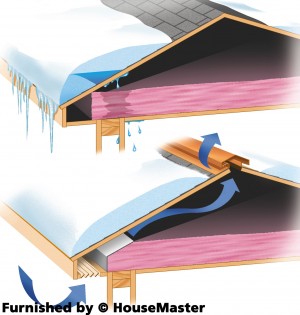 Many here in the Merrimack Valley are suffering with extreme Ice Dam issues right now. But what causes ice dams and how can you prevent them from happening again.To help, we reached out to one of our team home inspectors, Dave Cobosco of House Masters Inspections for a detailed report about ice dams, what causes them and how to prevent them in the future.
Many here in the Merrimack Valley are suffering with extreme Ice Dam issues right now. But what causes ice dams and how can you prevent them from happening again.To help, we reached out to one of our team home inspectors, Dave Cobosco of House Masters Inspections for a detailed report about ice dams, what causes them and how to prevent them in the future.
WHAT CAUSES ICE DAMS
Ice dams are caused by melting snow that refreezes along the lower edge of a roof, blocking the run-off from subsequent snow-melt. The heat within an attic that develops as a result of radiant heat from the sun or heat loss from the living areas of the house due to inadequate insulation is a contributing factor in the formation of ice dams. This heat typically rises to the higher points of the roof causing the snow cover to begin melting at those areas. As this melting snow runs down the roof surfaces below the snow, it contacts the colder areas of the roof along the edge or eave. Once it reaches this point, the cold roof surfaces cause the water to refreeze. The continuous freezing of the melting snow forms a noticeable dam of ice. As the water from the subsequent snow melt higher up on the roof arrives at the ice dam, it is blocked and begins backing up. Eventually it can seep in under the roofing materials, leaking through the roofing and sheathing into the attic and then to the living area where it causes stains and damage to the walls and ceilings below.
WEATHER CONDITIONS JUST RIGHT FOR ICE DAMS
For an ice dam problem to occur, there has to be a specific range of snowfall with cold temperature conditions. But ice dams tend to be most problematic in areas where January temperatures average 35°F (2°C) or where the mean average total snowfall is 6 to 8 inches. Ice dams are also more likely to occur in heavily treed areas, which do not benefit from the snow-clearing affect of prevailing winds.
HOW TO PREVENT ICE DAMS
There are many suggested solutions for eliminating ice dams, but many do not work, or will not work in certain situations. Removing accumulated snow or ice from the roof is the ultimate approach (find out more about removing snow off your roof now), but unless the removal is total, the melting process will begin and ice dams will eventually form. Attempting snow removal is also dangerous for inexperienced homeowners and expensive if a contractor is used after each snowfall. Also, the snow removal equipment can easily damage the surface of the roofing. Using steam or high-pressure water can also cause collateral damage as the water leaks into the house or refreezes on shrubs and walks.
Electric heating cables along the roof edge or in roof valleys have been employed as an attempted solution to ice dams for many years, but the heat pattern is usually irregular and secondary ice dams often form above the line of cables. Even the installation of two or three feet of metal flashings under the roof materials at the eaves has not solved the dilemma of ice dams in some cases, as once again secondary ice dams can occur above the level of the eave flashing.
PREVENTING ICE DAMS WITH THE COLD ROOF SOLUTION
Most roofing experts now agree that the only feasible solution to ice dams is the development of a “cold roof.” This solution involves a two-step approach. First, the amount of heated air reaching the underside of the roof must be minimized. Providing a full-thick and uniform layer of insulation (no voids) in the floor of an unfinished attic, particularly near the eave areas, will reduce the amount of heat seepage from the living areas of the house. The second step involves providing adequate attic ventilation at the eaves as well as upper areas of the attic (see image above). With good insulation and ventilation in place, the attic and roof sheathing stays cooler and snow-melt occurs more uniformly. This helps prevents the thaw-freeze cycle that leads to many ice dam problems.
Remember, these tips are only general guidelines. Since each situation is different, contact a professional if you have questions about a specific issue.
For more home safety and maintenance information or to speak with Dave for an inspection visit Dave Cobosco of HouseMasters

